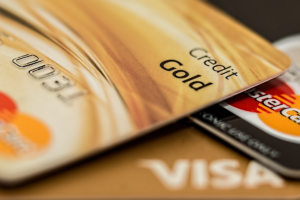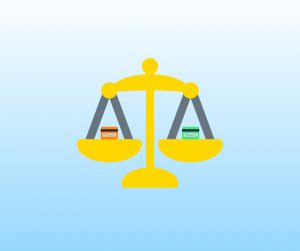Building Credit With Revolving & Open Credit Accounts

Easy Credit Hacks That Will Actually Get You Results
12/07/2023
Should You Trust AI Financial Advice?
12/22/2023 The right credit score can make a world of difference to your financial future. Not only can a good credit score make it possible to obtain financing for major purchases, but it can also help you lock in lower interest rates to potentially save thousands over the life of your loan.
The right credit score can make a world of difference to your financial future. Not only can a good credit score make it possible to obtain financing for major purchases, but it can also help you lock in lower interest rates to potentially save thousands over the life of your loan.
While a good credit score is important, building it might feel like an impossible task. If you want to build your credit score, responsibly managing revolving and open credit accounts can help. Let’s explore what these accounts are and how you can leverage these types of accounts into a better credit score.
Revolving Account Meaning
A revolving credit account is one that you can use repeatedly up to a certain limit as you pay it down.
With revolving credit, also known as open credit, the lender approves you to spend up to a specific limit. When you hit the spending limit, you won’t be able to access any more credit. However, you’ll have the option to pay off your balance along the way. Each time you pay off your balance, your credit limit is replenished.
You’ll have the option to carry over (“revolve”) some of your balance from each month to the next month. However, you’ll likely be required to make a minimum payment.
Examples of Revolving Credit Accounts
You might already have one of these credit accounts in your wallet. Below you’ll find a breakdown of some of the most popular credit accounts:
- Credit cards: Credit cards come with a credit limit, which means you can make purchases up to that limit. Each month, you can repay the issuer for all or a portion of your spending. Until the account is closed, you’ll have the option to make purchases on the card up to your limit.
 Personal lines of credit: Some financial institutions, like banks and credit unions, provide personal lines of credit. Typically, the lender allows you to withdraw money during a draw period, which means you can continue pulling out funds until the period is up. When you make a withdrawal, you’ll start making monthly payments, which can replenish your line of credit. After the draw period, you’ll be expected to make fixed monthly payments until you pay off the balance.
Personal lines of credit: Some financial institutions, like banks and credit unions, provide personal lines of credit. Typically, the lender allows you to withdraw money during a draw period, which means you can continue pulling out funds until the period is up. When you make a withdrawal, you’ll start making monthly payments, which can replenish your line of credit. After the draw period, you’ll be expected to make fixed monthly payments until you pay off the balance.- Home equity line of credit (HELOC): Homeowners who have built equity in their homes can use a HELOC to tap into the value of their equity. Essentially, you’ll put up your house as collateral for the loan. In most cases, HELOCs come with a draw period of several years during which you can withdraw funds. Along the way, you will start making payments. But after the draw period is over, you’ll make fixed monthly payments to repay all of the funds.
While these are just a handful of revolving account options, they should give you an idea of what these kinds of accounts look like.
How Do Revolving Credit Accounts Work?
A revolving credit account starts when the lender extends a line of credit with a credit limit attached. With this open-ended credit account, you can start spending funds. But you won’t be able to spend more than the credit limit.
Each month, you’ll have an opportunity to pay off your entire balance or a portion of the balance. If you cannot pay the entire balance, you can let part of your balance revolve into the next month. However, you’ll be required to make a payment of some amount each month.
As you make payments, your credit limit can be replenished. For example, if you have a credit limit of $1,000 and spend $100, then your available credit drops to $900. But when you pay the $100 balance, your credit limit will rise back to the original $1,000.
Revolving Credit Accounts and Interest
Like other types of credit, revolving credit accounts come with an interest rate and fees attached. While the exact interest rate and rules vary from lender to lender, here’s a general breakdown of interest payments tied to revolving credit accounts:
- Variable interest rates are the norm: Many revolving credit accounts have a variable interest rate attached. With that, the interest rate tied to your account may rise and fall based on market conditions.
- Interest rates are often high: Credit cards, a common type of revolving credit account, come with notoriously high interest rates. As of February 2023, the average interest rate on credit card accounts was 20.09%. With sky-high interest rates, it’s relatively easy to get caught in credit card debt.
- Interest isn’t assessed until after a grace period for credit cards: When it comes to credit cards, you won’t encounter any interest until after the grace period. Typically, the lender gives you between 21 and 30 days after the billing cycle to pay off your balance. If you pay off the entire balance on time each month, you won’t run into any interest charges.
When signing up for a revolving credit account, it’s essential to read the fine print. Within the terms and conditions, you’ll find everything you need to know about how interest is charged to your credit account.
How Revolving Credit Accounts Can Build Your Credit Score
Now that you know what a revolving credit account is, it’s time to learn how opening this kind of account can impact your credit score.
Utilization
When you open a revolving credit account, your credit utilization ratio becomes important. You can calculate your credit utilization ratio by dividing your revolving account balance by your credit limit. For example, if you have a $1,000 credit limit and a $300 balance, your credit utilization ratio would be 30%.
In general, you’ll want to keep your credit utilization ratio on the lower end because a lower credit utilization ratio helps your credit score. That’s because your credit utilization ratio is one part of the debt category that makes up 30% of your FICO credit score. While the debt category considers other factors, like the number of accounts with balances, your credit utilization ratio remains important.

As a rule of thumb, you should aim for a credit utilization ratio of less than 10% for FICO scores and less than 30% for VantageScores. Of course, it’s easy to spend more and increase your credit utilization ratio. But a credit utilization ratio over 10% can have a negative impact on your credit score.
Reporting
When you open a credit account of any kind, the lender is likely to report your account details to the credit bureaus. The credit bureaus use this information to create a credit report. Since the information on your credit report is the basis of your credit score, it’s essential to have positive information on your credit report.
If you choose to manage your credit accounts responsibly, the lender will be able to report positive payment information. A history of on-time payments leads to a higher credit score.
Opening a revolving credit account and managing it responsibly can help you build out a credit report full of positive information and earn a better credit score.
Credit Mix
Credit mix accounts for 10% of your credit score. In order to earn good marks for this category, you’ll need to open both revolving and installment credit accounts. In contrast to revolving credit accounts, installment credit accounts are one-time loans in which you receive a lump sum and pay it back in fixed monthly payments.
Potential lenders like to see that you can responsibly manage multiple types of credit accounts. If you already have installment loans, consider opening a revolving credit account to diversify your credit mix.
Tips to Make the Most of Your Revolving Accounts
If you decide to open a revolving account, the right credit management choices can make a big impact on your credit score. Here are some tips to help you make the most of this credit-building opportunity.
- Never spend more than you can afford: Pay off your balance in full every month. Otherwise, you could get stuck paying interest on your charges.
- Make all of your payments on time: If you miss payments, you will hurt your credit score.
- Monitor your credit report: As you manage your revolving account, the lender will report your activity to the credit bureaus. However, mistakes can happen. It’s a good idea to monitor your credit report to ensure that your credit isn’t negatively impacted by a mistake.
- Consider secured cards: If you are just getting started, you might not have the credit score you need for a premium credit card. But that doesn’t mean you should give up. Instead, consider starting with secured credit cards to make progress toward a better credit score.
Possible Downsides of Revolving Accounts
As with most credit-building tools, a revolving credit account is a double-edged sword. Here are some possible downsides to revolving credit accounts:
- Temptation to overspend: With a revolving credit account, you’ll receive a spending limit. In many cases, the limit is higher than you can truly afford to spend. If you aren’t confident in your ability to avoid overspending, then opening a revolving credit account might not be a good idea.
- Mismanagement: Making on-time payments to your credit account is essential. If you don’t make on-time payments, opening a revolving credit account could end up hurting your credit score. Luckily, you can often set up automatic payments to avoid accidentally missing a payment deadline.
Card Examples and Their Impact on Building Credit
If you are considering opening a revolving line of credit, a credit card is often a good place to get started. But not all credit cards are created equally. If you are looking to build credit, consider working with one of the credit card options listed below:
- Discover it® Secured Credit Card: If you are just starting your credit-building journey, a secured credit card might be the right solution. You’ll have to put down a security deposit to open the card, which acts as your credit limit. Plus, this option offers a pathway to upgrading to an unsecured card within 7 months, if you use the card responsibly.
- Capital One Quicksilver Secured Cash Rewards Credit Card: This is another secured credit card option. It’s a worthwhile choice for anyone with bad credit or no credit.
- Capital One Venture X: If you are looking for a premium rewards credit card, you’ll likely need an excellent credit score. But qualified cardholders will find attractive rewards that make this a great option, especially for people who want to stretch their travel dollars further.
FAQs
Is Opening a Lot of Credit Card Accounts a Good Way to Build Credit?
A wallet full of credit cards often leads to a higher total credit limit. If you manage multiple credit card accounts responsibly, having several cards may have a positive impact on your credit score. If possible, avoid applying for multiple credit cards at the same time because too many inquiries can have a negative impact on your credit score.
What Are the Fastest Ways to Build Credit?
Paying your bills on time every month is the most reliable way to build credit. As you create a history of on-time payments, you’ll see a growing credit score.
How to Get a 700 Credit Score in 30 Days?
There are a few quick credit-building methods and credit-boosting hacks you can try—so be sure to check out the articles in our Knowledge Center for tips!
However, keep in mind that building a good credit score often takes time. If you are starting with no credit or bad credit, you might need to wait longer before seeing a big boost in your credit score. Try to be patient with the process. A few ways to build credit include making on-time payments, using credit cards responsibly, and making sure the details on your credit report are accurate.
The Bottom Line
Revolving credit accounts can give you the tools you need to improve your credit score. As you start the credit-building journey, choose sound credit management strategies. Specifically, make sure to use your credit cards responsibly, avoid overspending, and always make on-time payments.





1 Comment
I want to revolve an account the best one you have